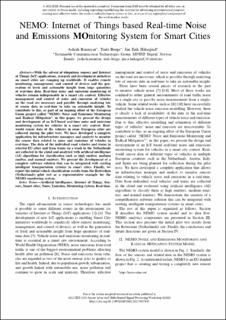| dc.contributor.author | Rauniyar, Ashish | |
| dc.contributor.author | Berge, Truls Svenn | |
| dc.contributor.author | Håkegård, Jan Erik | |
| dc.date.accessioned | 2022-10-05T12:29:24Z | |
| dc.date.available | 2022-10-05T12:29:24Z | |
| dc.date.created | 2022-07-29T13:44:10Z | |
| dc.date.issued | 2022 | |
| dc.identifier.citation | Proceedings of the IEEE Sensor Array and Multichannel Signal Processing Workshop. 2022, 206-210. | en_US |
| dc.identifier.issn | 1551-2282 | |
| dc.identifier.uri | https://hdl.handle.net/11250/3024071 | |
| dc.description.abstract | With the advent of ubiquitous sensors and Internet of Things (IoT) applications, research and development initiatives on smart cities are ramping up worldwide. It enables remote monitoring, management, and control of devices and the generation of fresh and actionable insight from huge quantities of real-time data. Real-time noise and emissions monitoring of vehicles remain indispensable in a smart city context. Effective management and control of noise and emissions of vehicles on the road are necessary and possible through analyzing lots of sensor data in real-time to take an actionable insight. To contribute to this, as part of an ongoing effort of the European Union project called ''NEMO: Noise and Emissions Monitoring and Radical Mitigation'', in this paper, we present the design and development of an IoT-based real-time noise and emissions monitoring system for vehicles in a smart city context. Real-world sensor data of the vehicles in some European cities are collected during the pilot tests. We have developed a complete application for infrastructure managers and analysts to monitor the sensor data related to noise and emissions of vehicles in real-time. The data of the individual road vehicles and trains in selected EU cities and from trains on a track in the Netherlands are collected in the cloud and analyzed with artificial intelligence (AI) algorithms for classification such as high emitter, medium emitter, and normal emitters. We present the development of a complete software solution that can be integrated with existing intelligent transportation systems in smart cities. Finally, we report the initial vehicle classification results from the Rotterdam (Netherlands) pilot test as a representative example for the NEMO monitoring system. | en_US |
| dc.language.iso | eng | en_US |
| dc.publisher | Institute of Electrical and Electronics Engineers (IEEE) | en_US |
| dc.subject | Maskinlæring | en_US |
| dc.subject | Machine learning | en_US |
| dc.subject | Støy | en_US |
| dc.subject | Noise | en_US |
| dc.subject | Emisjon | en_US |
| dc.subject | Emission | en_US |
| dc.subject | Intelligente Transportsystemer | en_US |
| dc.subject | Intelligent Transportation Systems | en_US |
| dc.title | NEMO: Internet of Things based Real-time Noise and Emissions MOnitoring System for Smart Cities | en_US |
| dc.title.alternative | NEMO: Internet of Things based Real-time Noise and Emissions MOnitoring System for Smart Cities | en_US |
| dc.type | Peer reviewed | en_US |
| dc.type | Journal article | en_US |
| dc.description.version | acceptedVersion | en_US |
| dc.subject.nsi | VDP::Informasjons- og kommunikasjonsvitenskap: 420 | en_US |
| dc.subject.nsi | VDP::Information and communication science: 420 | en_US |
| dc.subject.nsi | VDP::Informasjons- og kommunikasjonsvitenskap: 420 | en_US |
| dc.subject.nsi | VDP::Information and communication science: 420 | en_US |
| dc.source.pagenumber | 206-210 | en_US |
| dc.source.journal | Proceedings of the IEEE Sensor Array and Multichannel Signal Processing Workshop | en_US |
| dc.identifier.doi | 10.1109/SAM53842.2022.9827835 | |
| dc.identifier.cristin | 2040080 | |
| cristin.ispublished | true | |
| cristin.fulltext | postprint | |
| cristin.qualitycode | 1 | |
